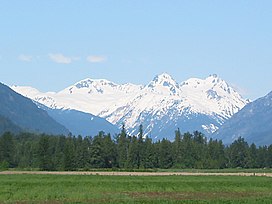| Mount Meager massif | |
|---|---|
 The Mount Meager massif as seen from the east near Pemberton. Summits left to right are Capricorn Mountain, Mount Meager and Plinth Peak. | |
| Highest point | |
| Peak | Plinth Peak[1] |
| Elevation | 2,680 m (8,790 ft)[1] |
| Coordinates | 50°40′0″N 123°31′0″W / 50.66667°N 123.51667°W[1] |
| Dimensions | |
| Length | 13 km (8.1 mi)[2] |
| Width | 9 km (5.6 mi) [2] |
| Volume | 20 km3 (4.8 cu mi)[2] |
| Geography | |
| Country | Canada[1] |
| Province | British Columbia[1] |
| District | Lillooet Land District[3] |
| Range coordinates | 50°38′N 123°03′W / 50.63°N 123.05°W[1] |
| Parent range | Pacific Ranges |
| Topo map | NTS 92J12 Mount Dalgleish[3] |
| Geology | |
| Formed by | Complex volcano[1] |
| Volcanic arc/belt | |
| Last eruption | 410 BCE ± 200 years[1] |
The Mount Meager massif is a group of volcanic peaks in the Pacific Ranges of the Coast Mountains in southwestern British Columbia, Canada. Part of the Cascade Volcanic Arc of western North America, it is located 150 km (93 mi) north of Vancouver at the northern end of the Pemberton Valley and reaches a maximum elevation of 2,680 m (8,790 ft). The massif is capped by several eroded volcanic edifices, including lava domes, volcanic plugs and overlapping piles of lava flows; these form at least six major summits including Mount Meager which is the second highest of the massif.
The Garibaldi Volcanic Belt (GVB) has a long history of eruptions and poses a threat to the surrounding region. Any volcanic hazard ranging from landslides to eruptions could pose a significant risk to humans and wildlife. Although the massif has not erupted for more than 2,000 years, it could produce a major eruption; if this were to happen, relief efforts would be quickly organized. Teams such as the Interagency Volcanic Event Notification Plan (IVENP) are prepared to notify people threatened by volcanic eruptions in Canada.
The Mount Meager massif produced the largest volcanic eruption in Canada in the last 10,000 years. About 2,400 years ago, an explosive eruption formed a volcanic crater on its northeastern flank and sent avalanches of hot ash, rock fragments and volcanic gases down the northern flank of the volcano. Evidence for more recent volcanic activity has been documented at the volcano, such as hot springs and earthquakes. The Mount Meager massif has also been the source of several large landslides in the past, including a massive debris flow in 2010 that swept down Meager Creek and the Lillooet River.
- ^ a b c d e f g h "Meager". Global Volcanism Program. Smithsonian Institution. Retrieved 2011-07-14.
- ^ a b c Hildreth, Wes (2007). Quaternary Magmatism in the Cascades—Geologic Perspectives. United States Geological Survey. pp. 7, 11. ISBN 978-1-4113-1945-5.
- ^ a b "Mount Meager". BC Geographical Names. Retrieved 2011-07-06.
